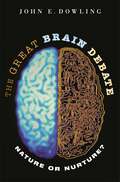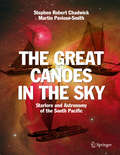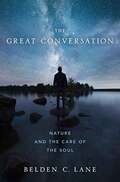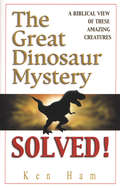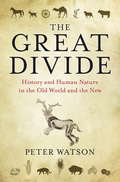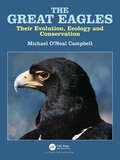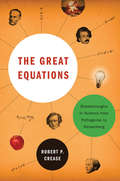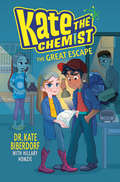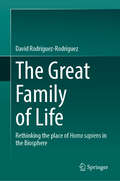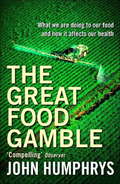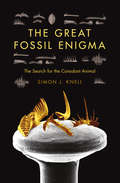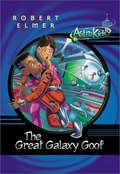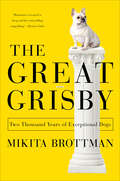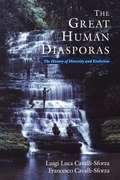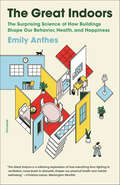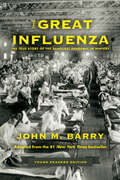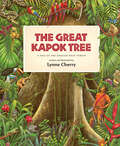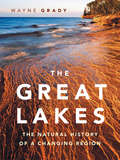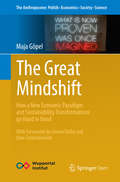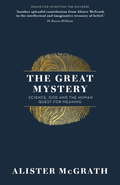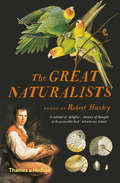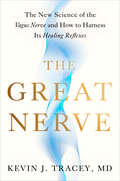- Table View
- List View
The Great Brain Debate: Nature or Nurture? (Science Essentials #15)
by John E. DowlingWhether our personality, intelligence, and behavior are more likely to be shaped by our environment or our genetic coding is not simply an idle question for today's researchers. There are tremendous consequences to understanding the crucial role that environment and genes each play. How we raise and educate our children, how we treat various mental diseases or conditions, how we care for our elderly--these are just some of the issues that can be informed by a better understanding of brain development. In The Great Brain Debate, the eminent neuroscience researcher John Dowling looks at these and other important issues. The work that is being done on the connection between the brain and vision, as well as the ways in which our brains help us learn new languages, are particularly revealing. From this groundbreaking new research, Dowling explains startling new insights into how the brain functions and how it can (or cannot) be molded and changed. By studying the brain across the spectrum of our lives, from infancy through adulthood and into old age, Dowling shows the ways in which both nature and nurture play key roles over the course of a human lifetime.
The Great Canoes in the Sky
by Stephen Robert Chadwick Martin Paviour-SmithPresenting spectacular photographs of astronomical objects of the southern sky, all taken by author Stephen Chadwick, this book explores what peoples of the South Pacific see when they look up at the heavens and what they have done with this knowledge. From wives killing brothers to emus rising out of the desert and great canoes in the sky, this book offers the perfect blend of science, tradition and mythology to bring to life the most famous sights in the heavens above the southern hemisphere. The authors place this starlore in the context of contemporary understandings of astronomy. The night sky of southern societies is as rich in culture as it is in stars. Stories, myths and legends based on constellations, heavenly bodies and other night sky phenomena have played a fundamental role in shaping the culture of pre-modern civilizations throughout the world. Such starlore continues to influence societies throughout the Pacific to this day, with cultures throughout the region - from Australia and New Zealand in the south to New Guinea and Micronesia in the north - using traditional cosmology as a means of interpreting various aspects of everyday life.
The Great Conversation: Nature And The Care Of The Soul
by Belden C. Lane"We are surrounded by a world that talks, but we don't listen. We are part of a community engaged in a vast conversation, but we deny our role in it." In the face of climate change, species loss, and vast environmental destruction, the ability to stand in the flow of the great conversation of all creatures and the earth can feel utterly lost to the human race. But Belden C. Lane suggests that it can and must be recovered, not only for the sake of endangered species and the well-being of at-risk communities, but for the survival of the world itself. The Great Conversation is Lane's multi-faceted treatise on a spiritually centered environmentalism. At the core is a belief in the power of the natural world to act as teacher. In a series of personal anecdotes, Lane pairs his own experiences in the wild with the writings of saints and sages from a wide range of religious traditions. A night in a Missourian cave brings to mind the Spiritual Exercises of Ignatius of Loyola; the canyons of southern Utah elicit a response from the Chinese philosopher Laozi; 500,000 migrating sandhill cranes rest in Nebraska and evoke the Sufi poet Farid ud-Din Attar. With each chapter, the humility of spiritual masters through the ages melds with the author's encounters with natural teachers to offer guidance for entering once more into a conversation with the world.
The Great Dinosaur Mystery Solved: A Biblical View of These Amazing Creatures
by Ken HamA dinosaur book like you've never seen before! Not only is the "dinosaur mystery" solved, but you'll be taught the TRUE history of the earth and its inhabitants! Your thinking about this world will never be the same again! A wealth of information combined into one volume, this fascinating book is a perfect addition to your family library!
The Great Divide: History and Human Nature in the Old World and the New
by Peter WatsonHow the division of the Americas from the rest of the world affected human history.In 15,000 B.C. early humankind, who had evolved in Africa tens of thousands of years before and spread out to populate the Earth, arrived in Siberia, during the Ice Age. Because so much water was locked up at that time in the great ice sheets, several miles thick, the levels of the world's oceans were much lower than they are today, and early humans were able to walk across the Bering Strait, then a land bridge, without getting their feet wet and enter the Americas. Then, the Ice Age came to an end, the Bering Strait refilled with water and humans in the Americas were cut off from humans elsewhere in the world. This division - with two great populations on Earth, each oblivious of the other - continued until Christopher Columbus 'discovered' America just before 1500 A.D. This is the fascinating subject of THE GREAT DIVIDE, which compares and contrasts the development of humankind in the 'Old World' and the 'New' between 15,000 B.C. and 1500 A.D. This unprecedented comparison of early peoples means that, when these factors are taken together, they offer a uniquely revealing insight into what it means to be human.THE GREAT DIVIDE offers a masterly and totally original synthesis of archaeology, anthropology, geology, meteorology, cosmology and mythology, to give a new shape - and a new understanding - to human history.
The Great Divide: History and Human Nature in the Old World and the New
by Peter WatsonHow the division of the Americas from the rest of the world affected human history.In 15,000 B.C. early humankind, who had evolved in Africa tens of thousands of years before and spread out to populate the Earth, arrived in Siberia, during the Ice Age. Because so much water was locked up at that time in the great ice sheets, several miles thick, the levels of the world's oceans were much lower than they are today, and early humans were able to walk across the Bering Strait, then a land bridge, without getting their feet wet and enter the Americas. Then, the Ice Age came to an end, the Bering Strait refilled with water and humans in the Americas were cut off from humans elsewhere in the world. This division - with two great populations on Earth, each oblivious of the other - continued until Christopher Columbus 'discovered' America just before 1500 A.D. This is the fascinating subject of THE GREAT DIVIDE, which compares and contrasts the development of humankind in the 'Old World' and the 'New' between 15,000 B.C. and 1500 A.D. This unprecedented comparison of early peoples means that, when these factors are taken together, they offer a uniquely revealing insight into what it means to be human.THE GREAT DIVIDE offers a masterly and totally original synthesis of archaeology, anthropology, geology, meteorology, cosmology and mythology, to give a new shape - and a new understanding - to human history.
The Great Eagles: Their Evolution, Ecology and Conservation
by Michael O'Neal CampbellThis book examines the current literature and knowledge on the evolution and ecology of all the birds named as eagles, with particular emphasis on the larger species. It also examines the past and current relations between eagles and people, including habitat change and conservation issues. Eagle ecologies and conservation are currently seriously impacted by human activities such as industrialization, urbanization, pollution, deforestation and hunting. Some eagle species have consequently experienced extreme population changes. There are, however, some positive developments. Eagles have a strong, historic bond with human civilization, due to their status as the world’s most charismatic birds. Conservation policies have also been successful in repopulating some ecosystems with breeding eagles. Therefore, despite the complexity of this relationship, there may yet be hope for this unique species group, frequently rated as the kings of birds, and symbolic of human power, ambition, royalty, nationality, and even concepts of God. It is hoped that this book will contribute to the further understanding of these unique and fantastic birds.
The Great East Japan Earthquake Disaster and Population Changes: A population geography of the Tohoku Region, Japan (SpringerBriefs in Population Studies)
by Takashi AbeThe book aims to clarify from a demographic and geographical perspective how population trends of the Tohoku Region were changed as a result of the GEJED. The author shows how different the 2011 GEJED was from past disasters in this region with regard to the impacts on population change in the Tohoku Region. He explains how the recent disaster is different from past disasters, based on the theories of the first and second demographic transitions. He also clarifies the causality between the extent of housing damage and mortality through geographical analysis. Furthermore, this book shows how migration patterns were changed before and after the GEJED, and it identifies the differences between the areas affected by the tsunami and by the nuclear power plant accident.Investigating the GEJED as a case study, the book presents a method to analyze the relationship between natural disasters and population change. This book is especially useful for researchers inthe fields of disaster, environment, and population to better understand the relationship between the environment and population.
The Great Equations: Breakthroughs in Science from Pythagoras to Heisenberg
by Robert P. Crease"Any reader who aspires to be scientifically literate will find this a good starting place."--Publishers Weekly While we may be familiar with some of science's greatest equations, we may not know that each and every equation emerged not in "Eureka!" moments but in years of cultural developments and scientific knowledge. With vignettes full of humor, drama, and eccentricity, philosopher and science historian Robert P. Crease shares the stories behind ten of history's greatest equations, from the "first equation," 1 + 1 = 2, which promises a rational, well-ordered world, to Heisenberg's uncertainty principle, which reveals the limitations of human knowledge. For every equation, Crease provides a brief account of who discovered it, what dissatisfactions lay behind its discovery, and what the equation says about the nature of our world.
The Great Escape (Kate the Chemist)
by Kate BiberdorfThe second installment of the Kate the Chemist series that shows kids that everyone can be a scientist!What do magnetic slime, a secret code, and the periodic table have in common? They're all part of the science-themed escape room that Kate's science teacher puts on for their class. Will Kate and her friends be able to use their science know-how to crack the code before time runs out?Praise for Kate the Chemist: Dragons vs. Unicorns:"Proves that science and fun go together like molecules in a polymer."--School Library Journal"It's a great introduction to the basics of Chemistry that is readily accessible to a variety of ages . . . . The way the everyday chemistry is blended in is done seamlessly, and has [me and my ten-year-old son] noticing how we are all doing a little bit of science everyday." --GeekMom.com
The Great Family of Life: Rethinking the place of Homo sapiens in the Biosphere
by David Rodríguez-RodríguezThis book explains the causes, consequences and desirable solutions to the unbalanced and unfair relationship between Homo sapiens and the other species that inhabit Planet Earth in a succinct, enjoyable and thought-provoking way. Major sociological, economic, political, educational, religious and phylosophical perspectives are reviewed in order to understand why we have reached the current alarming status of global biodiversity during the Anthropocene, and how we can react to it to attain not just human welfare, but global happiness. The target audience is wide, from the general public interested in the deep inner causes of environmental degradation, to college and university students and lecturers, notably in the fields of environmental ethics, environmental philosophy, environmental law and environmental politics.
The Great Food Gamble
by John Humphrys'Compelling' OBSERVER'Humphrys' level-headedness makes the arguments all the more powerful' SUNDAY TIMES'A concise, no-nonsense assessment of the true cost of cheap food: to the environment, the livestock, and the nation's long-term health' DAILY MAIL'A passionate discourse ... well-written and accessible' INDEPENDENT* * * * * * * * *John Humphrys is passionate about the state of British food, farming, fishing and agriculture. Here, he looks back to the days of organic farming in England when people shared and swapped food and considered the wildlife as well as the farmed animals, crops and fruits. He examines today's travesties: factory farming, pouring chemicals into the land, the scandal of the supermarket wars and cheap imported goods. He then turns to the future and asks: Can we save this ravaged earth and rebuild our community values? Most of all, can we reverse the damage to ourselves and our long-term health that may result from what we eat? John Humphrys' book requires the full attention of anyone who cares about themselves or the future.
The Great Food Gamble
by John Humphrys'Compelling' OBSERVER'Humphrys' level-headedness makes the arguments all the more powerful' SUNDAY TIMES'A concise, no-nonsense assessment of the true cost of cheap food: to the environment, the livestock, and the nation's long-term health' DAILY MAIL'A passionate discourse ... well-written and accessible' INDEPENDENT* * * * * * * * *John Humphrys is passionate about the state of British food, farming, fishing and agriculture. Here, he looks back to the days of organic farming in England when people shared and swapped food and considered the wildlife as well as the farmed animals, crops and fruits. He examines today's travesties: factory farming, pouring chemicals into the land, the scandal of the supermarket wars and cheap imported goods. He then turns to the future and asks: Can we save this ravaged earth and rebuild our community values? Most of all, can we reverse the damage to ourselves and our long-term health that may result from what we eat? John Humphrys' book requires the full attention of anyone who cares about themselves or the future.
The Great Fossil Enigma: The Search for the Conodont Animal (Life of the Past)
by Simon J. KnellA fascinating, comprehensive, accessible account of conodont fossils—one of paleontology&’s greatest mysteries: &“Deserves to be widely read and enjoyed&” (Priscum). Stephen Jay Gould borrowed from Winston Churchill when he described the eel-like conodont animal as a riddle wrapped in a mystery inside an enigma. The search for its identity confounded scientists for more than a century. Some thought it a slug, others a fish, a worm, a plant, even a primitive ancestor of ourselves. As the list of possibilities grew, an answer to the riddle never seemed any nearer. Would the animal that left behind the miniscule fossils known as conodonts ever be identified? Three times the creature was found, but each was quite different from the others. Were any of them really the one? Simon J. Knell takes the reader on a journey through 150 years of scientific thinking, imagining, and arguing. Slowly the animal begins to reveal traces of itself: its lifestyle, its remarkable evolution, its witnessing of great catastrophes, its movements over the surface of the planet, and finally its anatomy. Today the conodont animal remains perhaps the most disputed creature in the zoological world.
The Great Galaxy Goof (AstroKids #1)
by Robert ElmerMeet the Astrokids--Buzz, Miko, Mir, DeeBee, and Tag--five friends learning biblical truth through out-of-this-world adventures aboard space station CLEO-7. "You've never been to space? Oh yeah, of course not. You're still in the 21(st) century. Well, it's AWESOME! I was pumped when my family got to move here to CLEO-7. "That is, until this mystery kid popped up on my wrist interface. I didn't help things when I accidentally took his new zipsuit for a test flight (whoops!)... and then there was the whole space-shuttle mix-up ... What a mess! Thank goodness for my new friends, the AstroKids!"
The Great Grisby: Two Thousand Years of Exceptional Dogs
by Mikita BrottmanA scholar, psychoanalyst, and cultural critic explores the multifaceted role dogs play in our world in this charming bestiary of dogs from literature, lore, and life.While gradually unveiling her eight-year love affair with her French bulldog, Grisby, Mikita Brottman ruminates on the singular bond between dogs and humans. Why do prevailing attitudes warn us against loving our pet “too much”? Is her relationship with Grisby nourishing or dysfunctional, commonplace or unique? Challenging the assumption that there’s something repressed and neurotic about those deeply connected to a dog, she turns her keen eye on the many ways in which dog is the mirror of man.The Great Grisby is organized into twenty-six alphabetically arranged chapters, each devoted to a particular human-canine union drawn from history, art, philosophy, or literature. Here is Picasso’s dachshund Lump; Freud’s chow Yofi; Bill Sikes’s mutt Bull’s Eye in Oliver Twist; and Elizabeth Barrett Browning’s spaniel Flush, whose biography was penned by Virginia Woolf. There are royal dogs, like Prince Albert’s greyhound Eos, and dogs cherished by authors, like Thomas Hardy’s fox terrier, Wessex. Brottman’s own beloved Grisby serves as an envoy for sniffing out these remarkable companions.Quirky and delightful, and peppered with incisive personal reflections and black-and-white sketches portraying a different dog and its owner drawn by the enormously talented Davina “Psamophis” Falcão, The Great Grisby reveals how much dogs have to teach us about empathy, happiness, love—and what it means to be human.
The Great Human Diasporas: The History of Diversity and Evolution
by Luigi Luca Cavalli-Sforza Francesco Cavalli-SforzaLuigi Luca Cavalli-Sforza draws upon his lifelong work in archaeology, anthropology, genetics, molecular biology, and linguistics, to address the basic questions of human origins and diversity. Coauthored by his son, Francesco, the book answers age-old questions such as: Was there a mitochondrial Eve? Did the first humans originate in Africa or in several spots on the planet at about the same time? How did humans get onto North America, the tip of South America, and Australia?
The Great Indoors: The Surprising Science of How Buildings Shape Our Behavior, Health, and Happiness
by Emily AnthesAn Architectural Record Notable BookA fascinating, thought-provoking journey into our built environmentModern humans are an indoor species. We spend 90 percent of our time inside, shuttling between homes and offices, schools and stores, restaurants and gyms. And yet, in many ways, the indoor world remains unexplored territory. For all the time we spend inside buildings, we rarely stop to consider: How do these spaces affect our mental and physical well-being? Our thoughts, feelings, and behaviors? Our productivity, performance, and relationships?In this wide-ranging, character-driven book, science journalist Emily Anthes takes us on an adventure into the buildings in which we spend our days, exploring the profound, and sometimes unexpected, ways that they shape our lives. Drawing on cutting-edge research, she probes the pain-killing power of a well-placed window and examines how the right office layout can expand our social networks. She investigates how room temperature regulates our cognitive performance, how the microbes hiding in our homes influence our immune systems, and how cafeteria design affects what—and how much—we eat.Along the way, Anthes takes readers into an operating room designed to minimize medical errors, a school designed to boost students’ physical fitness, and a prison designed to support inmates’ psychological needs. And she previews the homes of the future, from the high-tech houses that could monitor our health to the 3D-printed structures that might allow us to live on the Moon.The Great Indoors provides a fresh perspective on our most familiar surroundings and a new understanding of the power of architecture and design. It's an argument for thoughtful interventions into the built environment and a story about how to build a better world—one room at a time.
The Great Influenza: The True Story of the Deadliest Pandemic in History (Young Readers Edition)
by John M. BarryThe strongest weapon against pandemic is the truth. Read why in the definitive account of the 1918 Influenza Epidemic, adapted for young readers from the #1 New York Times bestseller.At the height of World War I, history&’s most lethal influenza virus erupted in an army camp in Kansas, moved east with American troops, and then exploded worldwide, killing as many as 100 million people. It killed more in twenty-four months than AIDS killed in twenty-four years, more in a year than the Black Death killed in a century. It killed many more people than COVID-19, especially those who were young and otherwise healthy.This book, adapted from the #1 New York Times bestseller first published in 2004, shows young readers how this global tragedy came to pass; how science, war, and public policy collided; and how we might be able to prevent it from happening again. Impeccably researched and engrossingly told, The Great Influenza provides young readers with historical and scientific context for epidemics that remains all too relevant today.
The Great Kapok Tree: A Tale of the Amazon Rain Forest (Literature Units Ser.literature Units)
by Lynne CherryA modern fable with an urgent message for young environmentalists. "Spectacular." (School Library Journal)Lynne Cherry journeyed deep into the rain forests of Brazil to write and illustrate this gorgeous picture book about a man who exhausts himself trying to chop down a giant kapok tree. While he sleeps, the forest’s residents, including a child from the Yanomamo tribe, whisper in his ear about the importance of trees and how "all living things depend on one another" . . . and it works.Cherry’s lovingly rendered colored pencil and watercolor drawings of all the "wondrous and rare animals" evoke the lush rain forests. Features stunning world maps bordered by detailed illustrations of fascinating rainforest creatures.An IRA Teacher’s Choice * ABA Pick of the Lists * Reading Rainbow Review Book * NSTA-CBC Outstanding Trade Book for Children
The Great Lakes
by Wayne Grady Emily DamstraThe Great Lakes have been central to the development of eastern North America. In this "beautifully designed, comprehensive gem of a guide to the ecosystem at the heart of Canada" (The Tyee), award-winning science and nature writer Wayne Grady makes scientific concepts accessible as he reveals how human impact has changed this life-giving region.The Great Lakes: A Natural History of a Changing Region is the most authoritative, complete and accessible book to date about the biology and ecology of this vital, ever-changing terrain. Written by one of Canada's best-known science and nature writers, it is intended not only for those who live in the Great Lakes region, but for anyone captivated by the splendor of the natural world and sensitive to the challenges of its preservation. It is both a first-hand tribute and an essential guide to a fascinating ecosystem in eternal flux.
The Great Mindshift: How a New Economic Paradigm and Sustainability Transformations go Hand in Hand (The Anthropocene: Politik—Economics—Society—Science #2)
by Maja GöpelThis book describes the path ahead. It combines system transformation researchwith political economy and change leadership insights when discussing the needfor a great mindshift in how human wellbeing, economic prosperity and healthyecosystems are understood if the Great Transformations ahead are to lead to moresustainability. It shows that history is made by purposefully acting humans andintroduces transformative literacy as a key skill in leading the radical incremental change
The Great Mystery: Science, God and the Human Quest for Meaning
by Dr Alister E McGrathThere is currently huge interest in the question of human nature and identity, and what the human future might look like. Who are we? Why are we here? What is our future? Are we alone? And what can religion bring, alongside biology and anthropology, to these important and exciting questions?The Great Mystery focuses on this fascinating field of study. Alister McGrath, bestselling author and Andreas Idreos Professor of Science and Religion at Oxford University, explores the question of human nature from both scientific and religious perspectives, and weaves together the results to open up and explore some of the deepest and most important questions about who we are, why we matter, and what our future might be. A follow-up to his critically acclaimed Inventing the Universe, in The Great Mystery Alister McGrath once again brings together science with religion to yield an enriched vision of reality, along with rigorous and thoroughly up-to-date scholarship and intellectual accessibility.
The Great Naturalists
by Robert HuxleyThe story of natural history as seen through the lives, observations, and discoveries of the world’s greatest naturalists. “How the sciences of geology, biology, ecology and paleontology developed over three centuries is wonderfully illuminated in this volume.” —Publishers Weekly We owe a debt of gratitude to the naturalists who described, experimented, collected, and gave us the means to understand the natural world. They came from all over the globe, from classical times to the end of the nineteenth century, when natural history changed from a mainly amateur pursuit to today’s specialized scientific profession. Braving dangers—including storms, pirates, and disease—in pursuit of cataloging the natural world, pioneers such as Alexander von Humboldt and Charles Darwin changed the course of science with their groundbreaking theories. This book includes many naturalists who are well known, such as the earliest great natural historian, Aristotle; Carl Linnaeus, the man who brought order to nature; the ornithologist and painter John James Audubon; and Georges Cuvier, who established the concept of extinction. Others are now given their rightful place: Antony van Leeuwenhoek, who made his own microscopes and discovered bacteria; and Mary Anning, “the princess of paleontology,” who had an amazing, self-taught talent for finding fossils. Many of these people were great artists as well as scientists, and The Great Naturalists is illustrated with a selection of beautiful and precise paintings and drawings of birds, animals, fossils, fish, shells, and rocks from the unparalleled collections of the Natural History Museum, London.
The Great Nerve: The New Science of the Vagus Nerve and How to Harness Its Healing Reflexes
by Kevin J. Tracey MDNew science reveals the groundbreaking potential of the vagus nerve to regulate your body&’s vital systems and heal a wide variety of medical conditions without drugsThe vagus nerve is fundamental to our health and vitality, coordinating critical functions from the precise heartbeat we need to exercise or rest to the balance of appetite and digestion. Made up of 200,000 fibers, the vagus nerve sends thousands of electrical signals every second between your brain and your most important organs. Yet despite its essential role in life, important vagus nerve functions have eluded centuries of scientific investigation. Now neurosurgeon and researcher Kevin Tracey has discovered the previously unknown power of the vagus nerve to reverse inflammation, balance the immune system, treat chronic illness, and keep our organs humming together in harmony. In The Great Nerve, Dr. Tracey shows us how stimulating the vagus nerve with a tiny electrical implant has the potential to reverse life-altering diseases like rheumatoid arthritis, inflammatory bowel disease, lupus, MS, diabetes, obesity, stroke, depression, Alzheimer&’s and Parkinson&’s. If this sounds too good to believe, Dr. Tracey shares stories of patients who have gone from being nearly bedridden to running and dancing, along with the science that makes possible these recoveries. He also explains the evidence for lifestyle strategies like ice baths, meditation, exercise, and breathwork that can maintain and improve vagus nerve function. By opening the door to the new field of neuroimmunology, The Great Nerve not only revolutionizes how we understand and treat disease, it gives us unprecedented hope for our health. This is the story of your body&’s ability to heal itself.
